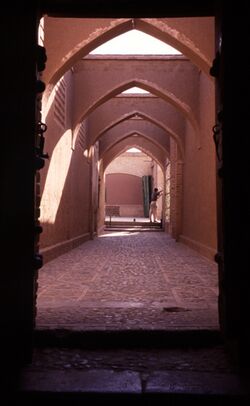Kucheh
Topic: Engineering
 From HandWiki - Reading time: 2 min
From HandWiki - Reading time: 2 min
In traditional Persian architecture, a kucheh or koocheh (Persian: کوچه), is a narrow especially designed alley.[1] Remnants of it are still seen in modern Iran and regional countries.
Before modernization, Persia's old city fabric was composed of these narrow winding streets, often made with high walls of adobe and brick, and often roofed at intervals. This form of urban design, which was commonplace in Persia, is an optimal form of desert architecture that minimizes desert expansion and the effects of dust storms. It also maximizes daytime shading, and insulates the “fabric” from severe winter temperatures.
A Kucheh in Yazd
References
- ↑ Fallāḥʹfar, Saʻīd (سعید فلاحفر). The Dictionary of Iranian Traditional Architectural Terms (Farhang-i vāzhahʹhā-yi miʻmārī-i sunnatī-i Īrān فرهنگ واژههای معماری سنتی ایران). Kamyab Publications (انتشارات کامیاب). Kāvushʹpardāz. 2000, 2010. Tehran. ISBN:978-964-2665-60-0 US Library of Congress LCCN Permalink: http://lccn.loc.gov/2010342544 pp.182
 |
Licensed under CC BY-SA 3.0 | Source: https://handwiki.org/wiki/Engineering:Kucheh15 views | Status: cached on July 15 2024 22:58:51↧ Download this article as ZWI file
 KSF
KSF




